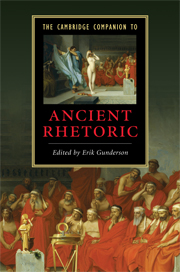Book contents
- Frontmatter
- Introduction
- Part 1 An archaeology of rhetoric
- Part II The field of language
- Part III The practice of rhetoric
- 8 Types of oratory
- 9 Rhetoric of the Athenian citizen
- 10 Rhetoric and the Roman Republic
- 11 Staging rhetoric in Athens
- 12 The drama of rhetoric at Rome
- 13 Rhetoric and the Second Sophistic
- Part IV Epilogoues
- Appendix 1: Rhetorical terms
- Appendix 2: Authors and prominent individuals
- References
- Index of passages
- Index of subjects
- Series list
10 - Rhetoric and the Roman Republic
from Part III - The practice of rhetoric
Published online by Cambridge University Press: 28 January 2010
- Frontmatter
- Introduction
- Part 1 An archaeology of rhetoric
- Part II The field of language
- Part III The practice of rhetoric
- 8 Types of oratory
- 9 Rhetoric of the Athenian citizen
- 10 Rhetoric and the Roman Republic
- 11 Staging rhetoric in Athens
- 12 The drama of rhetoric at Rome
- 13 Rhetoric and the Second Sophistic
- Part IV Epilogoues
- Appendix 1: Rhetorical terms
- Appendix 2: Authors and prominent individuals
- References
- Index of passages
- Index of subjects
- Series list
Summary
In the Aeneid’s first simile Vergil compares Neptune calming raging storm winds to a Roman magistrate who pacifies a seditious crowd threatening arson and stone throwing (Aeneid 1.148-53). The mere sight of the man, someone “of consequence because of his deserved reputation for responsibility,” causes the crowd, like a pack of animals with their ears pricked up, to stand still. The orator then “rules their souls with his words and soothes their hearts.” The epic’s first extended trope offers the image of the power of an orator to bridle the passions of an unruly, plebeian mob. Rhetoric here contains dangerous elements in Roman society, putting anarchic forces back into their place like the winds that Aeolus released from their cages. A member of the elite vested with personal authority uses speech to control internal threats to the state. It is a process where the top strata of society rein in those at the bottom, and speech suppresses wild disruptions.
Vergil turns a central trope within Republican Roman rhetoric inside out – exchanging what is figurative (the political storms roiling the state) for literal tempests, while the real presence of the orator becomes, in more than one sense, a figure of speech. The reduction of the Republican orator (or, at least, a version of the Republican orator) to an image within the Aeneid is symbolic of a cultural shift that took place under the age of Augustus, a regime whose ascendancy Vergil’s poem heralds. In the Aeneid the orator is an artifact from an earlier age, a person whose previous political and cultural importance has passed into memory. This essay will explore both the special role of oratory within the Roman Republic and, chiastically, how the Republic figures within Roman oratory.
- Type
- Chapter
- Information
- The Cambridge Companion to Ancient Rhetoric , pp. 178 - 193Publisher: Cambridge University PressPrint publication year: 2009
- 5
- Cited by

